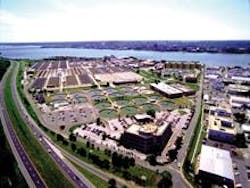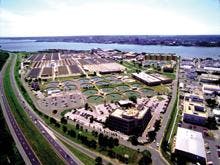New CIS Enhances Service Delivery, Customer Relations
By Charles Kiely
Since becoming a semi-autonomous entity in 1996, the District of Columbia Water and Sewer Authority (WASA) has implemented key information and technology initiatives that enabled WASA to transition to a premier service provider.
Confronted with an aging infrastructure, high operational costs, inaccurate billings and poor customer relations, WASA integrated its customer service improvement plan with Orcom's outsourcing model to deliver improved service to its customers.
Since replacing its legacy technology with Orcom's next-generation Customer Information System (CIS), WASA has enhanced service delivery and customer relations. In turn, this has led to more efficient operations and cost savings at a time when companies are coming under increasing pressure to reduce costs and eliminate non-core services, while improving profitability, quality and service.
Less than a year after coming on board in 2000, Orcom was able to go live with the WASA's 125,000 accounts. The implementation exceeded expectations and was delivered within budget in less than one year – one of the faster major system integrations on record. This seamless transition enabled WASA to immediately begin improving its billing and collection operations.
The legacy program – a makeover of another utility's billing system from the 1970's – provided WASA little functionality. For example, the old system did not associate names to billing addresses, offer customized payments, record changes, nor support different rate structures. Service order processing was manual in the legacy system. In addition, late fee notices and thousands of monthly bills all had to be processed manually.
The new CIS, however, has enhanced billing and collections by giving WASA more control through automation. This has mitigated manually intensive tasks that usually push up labor costs associated with legacy systems. Leveraging automation also enabled WASA to improve workflow, better monitor performance and improve customer care.
Orcom's system has improved billing accuracy by matching names to bills and facilitating an automatic meter reading process. WASA can easily maintain records of customer calls and track accounts that are not being paid. In addition, the system automatically processes monthly and quarterly bills, as well as generates late fee notices. The automated system has also made easier the implementation of new rates and programs.
While fortifying internal operations, WASA has also enhanced customer care. For example, it now offers customized payment terms and automatic generation of a letter detailing the agreement. And unlike the legacy system, the new CIS can accept automatic debit and credit card payments.
Since teaming up with Orcom, WASA has introduced a low income homeowners program that gives discounts to those who meet certain criteria. Moreover, WASA has the capability to provide budget billing options that allow customers to avoid higher bills in the summer by averaging payments out over 12 months. This service is currently being studied, along with an innovative finance program to help customers pay for service line upgrades.
Orcom has also made significant inroads in automating WASA's collection efforts. With the legacy system, WASA manually typed up and sent out letters regarding delinquent accounts. These days, the new system automatically generates intent to lien and lien notices for customers in debt. This has enabled WASA to act on delinquent accounts in a more timely manner, which translates into more dollars recovered.
In addition, bad debt is automatically separated from account receivables. After the debt becomes a certain age, it is alienated from other debts so that WASA can view what is realistically collectable.
In an effort to maintain profiles on customers, the new system also keeps electronic files on payments and develops credit reports. The system records ticks for customers who have trouble paying their bills and develops overall credit ratings for accounts. If a customer has a history of passing checks with insufficient funds for example, the system can code the account to not accept this type of payment.
Aside from improving billing and collection efforts, Orcom has been a critical player in WASA's meter replacement initiative. WASA is currently in the process of replacing 130,000 water meters with state-of-the-art automated meter reading technology. Orcom has contributed to this effort by developing an interface that automatically generates mass service orders for the meter replacements. Otherwise, a tremendous amount of human resources would have been required to manually process these orders in a timely manner.
Ultimately, the meter replacement is expected to improve revenue, offer more accurate readings and improve customer service.
For example, the meter reading program will be integrated with the customer billing and information system, allowing customers to retrieve daily meter readings and water usage information through the WASA web site.
Overall, by outsourcing these services — rather than replacing the existing in-house legacy system — WASA has reduced its expenses by avoiding a large capital investment in CIS software and high-risk implementation process, as well as the annual overhead to operate the system in-house.
In addition to capital expenses, maintaining an in-house CIS system requires extensive ongoing costs. Without Orcom, WASA would need support staff, data networks, billing operations and the IT staff to manage the CIS solution. Funds would also need to be available for hardware and software maintenance, as well as technology updates.
Orcom's immediate delivery of high levels of service has helped WASA overcome the infrastructure and customer care problems that marred previous decades of operation. Information and technology initiatives have been the linchpin of its modernization success.
By releasing the reins of non-core services to an outsourcer with a proven capability, WASA has increasingly focused on core operations while improving the bottom line and enhancing customer satisfaction.
About the Author: Charles Kiely is Customer Service Director for the District of Columbia Water and Sewer Authority. Kiely brings over 18 years of customer service experience in the gas, electric and water utility industries. Before joining the District of Columbia Water and Sewer Authority's customer service team, Kiely was the Vice President of Customer Services at NSTAR and Vice President of Customer Services at COM/Energy, two Massachusetts-based utilities. Under his leadership and direction, these utilities were leaders in delivering value-added products and services to their diverse customer bases. Kiely holds a BS in Management from the University of Massachusetts and an MBA in Management Information Systems from Bentley College.
